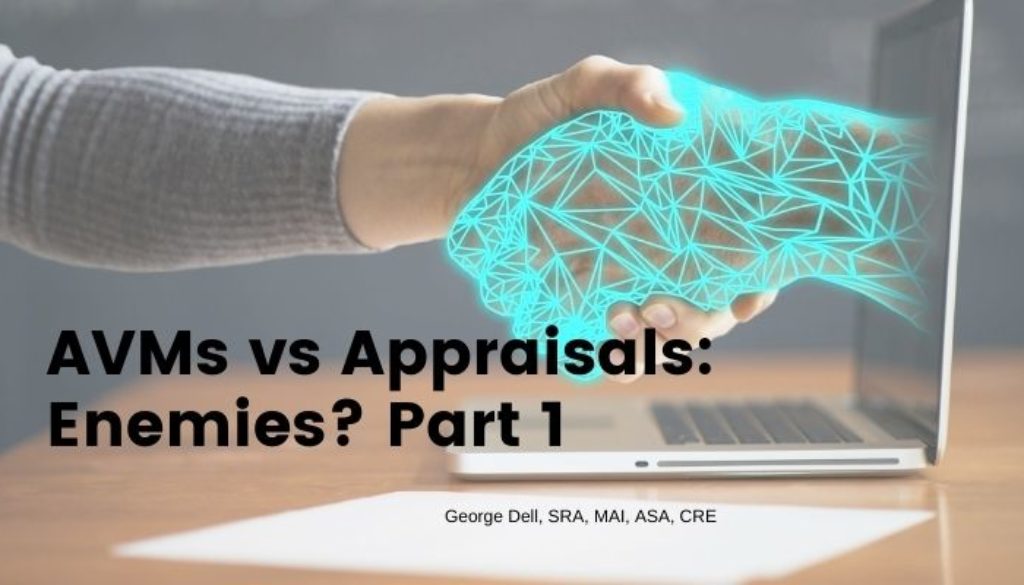AVMs (Automated Valuation Models) have been around for over 20 years now. Appraisals have been around for 100 years now. Why no winner?
Let’s look. This is the first part in a series of coming blogs that will compare and contrast “automated” versus “opinion” valuations. Stay tuned to hear the unexpected surprise climax of this rising debate.
Let’s look back at the fundamentals. For now, let’s look just at loan (collateral) valuations. What are the goals? And what causes one to be decided over another? First, we see the obvious:
- Cheaper is better. Easy.
- Faster is better. Easy.
- Not so easy.
Reliability (ability to rely on) itself has four components:
- Trueness (accuracy, or closeness to the true value). Inaccuracy may be due to:
- Bias, which may be personal, or analytical, or from use of the wrong model;
- Uncertainty, which may be from the data, or from the model;
- Sureness (precision, or closeness of repeated measurements to each other). Unsureness, or uncertainty may be due to:
- Data quantity, quality, completeness, comprehensiveness, and appropriateness;
- Model appropriateness (or not).
- Appropriateness (right question right target):
- Right question – A part of the “scope of work” of an appraiser is to counsel the client. At times, clients may not be aware of their influence on the question asked.
- Right model – The process or algorithm to solve a problem is a choice. As an example, traditional appraisal forces a selection from the “three approaches.” Each of the three approaches is considered a model, as well as is the overall appraisal process.
- Coverage: The proportion of jobs that can be performed is important to both AVMs and appraisals. Different AVMs have different hit rates in different market areas and with different property characteristics. AVMs will simply fail to return a response. Different appraisers have varying competencies, where they should disqualify themselves when they do not have the appropriate competency. Appraisers simply decline an assignment.
AVMs are cheap and fast. As a very rough comparison, an AVM costs about 10% of the cost of a point-value opinion by a licensed appraiser. Most AVMs take but a few minutes to run and consider the answer. Another benefit of AVM output is that the point-value can be directly plugged into other management, underwriting, and review algorithms.
They have varying levels of trueness and sureness. Appropriateness is assumed (in this case that the property is an SFR). The “hit rate” is a measure of coverage. Each AVM purveyor provides their own evaluation of their own product, usually called an “FSD” (forecast standard deviation), which itself is the result of some black box algorithm.
Appraisals take several days, and normally involve a physical inspection as well as viewing of the chosen comparable sales. Appropriateness is implicit in the “Highest and Best Use” analysis, resulting in a check box on the “Fannie Mae form.”
Appraisal standards focus on “credibility” – defined as “worthy of belief.” Any goal of objectivity (in USPAP) focuses on the appraiser mindset, rather than data-analytic objectivity.
To sum up (Part I of a multi-part series):
AVMs are an industry, not a given ‘model,’ with each working off of proprietary black box algorithms.
Appraising is a vocation, with the models of a proprietary dark-gray cranial algorithm.
In coming editions of AVMs vs Appraisals, we will consider each of the elements of valuation and risk assessment: subject depiction, data “comp” selection, predictor identification, predictive “adjustment” algorithms, assurance (reconciliation/FSD), and communication (numerical, visual, interactive, and reproducibility).

September 9, 2020 @ 5:54 am
Interesting discussion George! AVMs and Appraisals have their own appropriateness of use.
September 11, 2020 @ 12:39 pm
For fun, I have sometimes run an AVM of my home & site on Zillow, e.g. The AVM was off by more than 100%. The extended neighborhood I live in has zero lot line (attached) homes on small lots and about 1750 sf and also larger more upscale better quality homes averaging about 2500 sf on 1/2 acre or larger lots. My home, an adobe, split foyer contemporary on 1/2 acre w/refrig hvac in an all electric neighborhood (a gas moritorium was in effect when the area was developed). The AVM’s reliance on the zero lot line homes of which there are more and sales are more frequent resulted in the 100%+disparity. AVM’s aren’t only OUR enemies, they are the PEOPLE’S ENEMY.. Ken Odenheim, ASA, IFAS